Terebess-kert
különlap
«
vissza a Terebess Online nyitólapjára
«
vissza a Kertek
és konyhák indexlapra
Ehető
rovarok
Insect
as Food - Entomophagy
Rovartani
műszótár
The
Human Use of Insects as a Food Resource
Csúszómászó
eledelek (képgaléria)
![]()

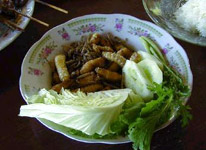

Magyarország
Az európai ember a rovarokat, bogarakat nem is tekinti már tápláléknak. Az ősi hagyományokat őrző afrikai, dél-amerikai stb. törzsek táplálékának még ma is fontos részét képezik a rovarok, bogarak, hernyók, lárvák stb.
A lábától megfosztott szöcskéket, sáskákat az arabok nyersen és megfőzve is rendszeresen fogyasztják.
A dél-amerikai és az ausztrál bennszülöttek a korhadt fák kérgét szinte mindig lehántják, hogy az alatta levő lárvákat, kukacokat összeszedjék.
A giliszta nálunk az egyik legkönnyebben megszerezhető táplálék. Megtalálásához csupán egy nedvesebb földön le kell ásni. Elkészítésük főzéssel és sütéssel is történhet. A gondosan lemosott gilisztát zsilettpengével vagy éles késsel hosszában felvágjuk, és a belső, földes részt kivesszük belőle. Zubogó vízbe téve 10-15 percig kell főzni. Sütéssel ízletesebben elkészíthető. Az előkészített gilisztát üres konzervdobozok tetejére téve vagy vaslemezen sütjük. Célszerű a parázs felett készülő gilisztákat időnként megforgatni.
A hangyák sütve, főzve, de még nyersen is fogyaszthatók. A hangyatojás igen magas fehérjetartalmú és kalóriadús táplálék. A hangyatojás egyenkénti szedése időigényes, fárasztó tevékenység, ezért célszerű a gyűjtésükre a "tajgai módszert" átvenni: a magyar erdőkben is találhatók kisebb-nagyobb hangyabolyok mellé leterítünk egy PVC fóliát vagy sátorlapot, de a célnak akár még egy poncsó is megfelel. Néhány ágat teszünk rá úgy, hogy az annak mindössze kb. 1/3 területét foglalja el. Az ágakra úgy hajtjuk rá a poncsót, hogy pár cm-es hézag maradjon a felhajtott poncsó és a földön maradt esővédő között. Ez után a hangyabojt megbontjuk egy ásóval, és a hangyatojások elérésekor a földet a tojásokkal a poncsóra szórjuk. A hangyák a felszínre került tojásokat néhány perc alatt beviszik a ponyva alatti árnyékos részre. Innét már csak a tojásokat kell összeseperni. A sült hangyatojás íze nagyon hasonlít a garnéla rákéhoz, és könnyen emészthető táplálék.
A cserebogár, szarvasbogár, csibor, és más hasonlóan erős páncélzatú bogár esetében célszerű a páncélt, szárnyfedőket eltávolítani, mivel ezek a részek nehezen emészthetőek.
A méhek, darazsak is fogyaszthatók, csupán a fullánkos potroh részt kell csak a mérgek miatt levágni. Nedves avarral, vizes fűvel kifüstölhetjük a méheket az odújukból, és a mézen, lépen felül, szükség esetén még a rovarokat is fogyaszthatjuk.
Tóth Lóránd: Katonai túlélés
Rovarkereső
•
Selyemhernyó-báb
- Bombyx mori
silk-worm pupae, boondaegi [Korea]
A gubó legombolyítása után
felszabaduló bábját a Távol-Keleten eszik, édeskés és krémes íze van.
pete
> hernyó > gubó > báb > pille (v. selyemlepke)
to pupate = bábbá
alakul át, bebábozódik
selyemlepke
(Bombyx), a lepkék (Lepidoptera) rendjének selyemlepkefélék (Bombycidae) családjába tartozó rovarnem; fajai, mindenekelőtt a tenyésztett B. mori termelik a selyem alapanyagát. A Kínában őshonos, lényegében háziasított selyemlepkét mára a világ minden táján meghonosították. A kifejlett lepke szárnyfesztávolsága 40-50 cm, teste vaskos és szőrös. Lepke alakban mindössze 2-3 napig él, csak néha repül, és nem táplálkozik. A nőstény 300-500 petét rak le. A selyemhernyó természetes tápláléka az eperfa levele, de a narancseperfa levelét és a salátát is elfogyasztja. Csupasz, vajszínű hernyójának jellegzetes, szarvszerű nyúlványa van a potroh végén. A legnagyobb, 75 mm-es hosszt 45 napos fejlődés után éri el. A hernyó egyetlen (kb. 1000 m hosszú), fehér vagy sárgás színű selyemszálból szőtt gubóba bábozódik.
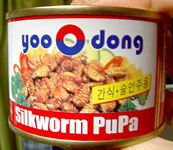
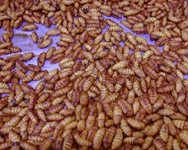
selyemhernyó-báb konzerv Koreából
•
Ganajtúró
(szkarabeusz, galacsinhajtó)
dung beetle
(add a wholesome flavour to curries)
•
Madárpók
A nagyobb tarantula
pók íze állítólag a rákéhoz hasonlít. Hogy elkészítsd őket, először kösd hátra
a lábait aztán dobd a parázsra.
• Skorpió
•
Sajtatka
- Tyroglyphus casei Oudm.
Szabad szemmel csak kis fehéres, alig észrevehető
pontnak tűnik fel, mikroszkóp alatt azonban kövér, hosszú szőrökkel borított állatnak
látjuk, melynek teste két részre tagolódott és lábai kis tapadókorongban végződnek.
Milliószámra élnek öreg, kőkemény sajtokban és idővel azokat teljesen porrá őrlik,
ez a porrá őrölt tömeg nem egyéb, mint az atkák ürüléke és levedlett bőre.
Egyes
sajtok kérge a benne található sajtatkák ürüléke és levedlett kitinrétegei miatt
szürke színű.
•
Tücsök
cricket
Valamennyi tücsök ehető életciklusa minden stádiumában. Íze a garnélarákéra
emlékeztet.
Crickets and grasshoppers can add protein,
calories, fat and variety to a meager diet. Crickets to include mole crickets
and Mormon crickets and grasshoppers are the most common insects eatenworldwide.
All are edible to include at all stages of their life cycle.
tücsökfélék
(Gryllidae), az egyenesszárnyúak (Orthoptera) rendjébe tartozó család kb. 2400, ugróképes rovarfajjal. A hímek dallamos ciripelésükről nevezetesek. A tücskök hossza 3-50 mm között változó. Csápjuk vékony, hátsó lábpárjuk ugrásra módosult, lábfejük háromízű, és potrohvégükön két vékony érzőfüggelék (fartoldalék, cercus) található. Az elülső szárnypár merev és bőrszerű, a két hosszú, hártyás hátsó szárny szolgál a repülésre.
A hím tücskök úgy ciripelnek, hogy egyik elülső szárnyukon lévő „vonójukat” a másik szárnyon lévő, 50-250 fogból álló léchez dörzsölik. A cirpelés frekvenciája a másodpercenkénti fogérintések számától függ, és 1500 hertztől (legnagyobb tücsökfajok esetében) majdnem 10 000 hertzig terjed (a legkisebbeknél). A leggyakoribb tücsökdalok közül a hívóének a nőstényeket csalogatja; az udvarlási vagy párzóének párzásra készteti a nőstényt, a harci dal pedig elűzi a többi hímet. Mindkét nem elülső lábán igen érzékeny hallószerv helyezkedik el. Közvetlen összefüggés van a tücsökciripelés gyakorisága és a hőmérséklet között: a hőmérséklet emelkedésével a gyakoriság növekszik.
A nőstény tücskök többsége a talajba vagy növényszárakba tojja petéit hosszú, vékony tojócsövével; ezzel néha nagy kárt tesznek a növényekben. A legtöbb tücsökfaj ősszel párzik és rakja le petéit. A nimfák tavasszal kelnek ki, és 6-12 vedlés után válnak ivaréretté; a kifejlett tücskök rendszerint 6-8 hétig élnek.
A Gryllinae alcsaládba tartozó mezei (Gryllus campestris) és a házi tücsök (Acheta - korábban Gryllus domesticus) zömök, fekete vagy barna testű és gyakran sekély lyukat ás. Növényekkel, állatokkal, ruhaanyaggal, sőt egymással táplálkozhatnak. A mezei (vagy fekete) tücsök gyakori a mezőkön és az udvarokban, s néha épületekbe is behatol. Az Európában őshonos, Észak-Amerikába is behurcolt házi tücsök feje világos színű, sötét keresztcsíkokkal. Épületekben, valamint szemétkupacokban fordul elő. A házi és mezei tücsök nappal és éjszaka is ciripel. Némely országokban halcsaliként, sőt biológiai laboratóriumokban is használják ezeket a rovarokat.
Az erdei tücskök (Nemobiinae vagy néha Gryllinae) kb. 12 mm hosszúak, általában legelőkön és erdős területeken fordulnak elő. Énekük lágy, magas frekvenciájú trillák sorozata. A csíkos erdei tücsök (Nemobius vittatus) potrohán három sötét csík húzódik.
A pirregő tücskök (Oecanthinae) fehér vagy zöld színűek, szárnyuk átlátszó. Hasznosak az ember szempontjából, mert pusztítják a levéltetveket, de a nőstények peterakáskor megsebzik az ágakat. Többségük dala hosszú trilla.
A hangyásztücskök (Myrmecophilinae) parányi (3-5 mm-es), szárnyatlan és púpos hátú rovarok. Hangyabolyokban élnek.
A bogártücskök (Trigonidiinae) 5-10 mm hosszúak, barnák és kard alakú tojócsövük van. Jellemzően valamilyen tavacska melletti bozótban fordulnak elő.
A tücskökhöz sokféle babona fűződik. Jelenlétüket a jó szerencse és az intelligencia jelének tekintik; bántásuk állítólag balszerencsét okoz. Kelet-Ázsiában hím tücsköket tartanak kalitkában énekük kedvéért, ill. „házőrzőként” (ember közeledtére vagy más hasonló változásra elhallgatnak), és Kínában évszázadokon át népszerű sport volt a tücsökviadal.
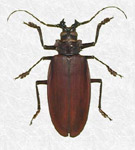
• Óriáscincér
-Titanus giganteus
A jelenleg ismert legnagyobb rovarfaj nagyjából 15 cm-re
nő meg, legnagyobb talált példánya 16,7 centiméteres volt. Ez a Dél-Amerikában
élő cincérfaj egyébként igen ritka és veszélyeztetett, mivel a bennszülött indiánok
előszeretettel fogyasztják a lárváit.
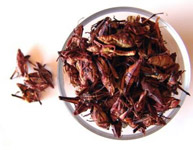
• Szöcske,
pirított
chapulines [Mexikó], grasshopper
Ízük a zöldpaprikára emlékeztet.
Thaiföldön
a szöcskét kiöntik a csapdából, megmossák őket, aztán harminc percig serpenyőben
sütik, miközben jól befűszerezik. A szöcskék, sáskák stb. hártyás szárnyát nem
eszik meg, annál lehet megfogni őket, ha falatozik belőlük az ember.
Japánban
a rizsföldi szöcskéket pirítva eszik: inago.
http://saveursmexicaines.blogspot.com/2005/11/craquant.html
http://www.hollowtop.com/finl_html/grasshoppers.htm
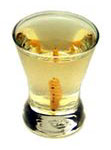

• Gusano
- Hypopta agavis, egy éjjeli lepke hernyója
mezcal con gusano, caterpillar
Kukac a mezcalban - balfogásból reklámfogás!
Az elkukacosodott agávét nem
szokták leszüretelni, mert nem ad jó minőségű italt. Egy bizonyos hozzá nem értő
kisvállalkozó, Jacobo Lozano Páez az 1940-es években nem tudván, mit tegyen a
talált kukacokkal, azt állította javít a mezcal ízén, ha tesznek bele. (Megfelelően
előfőzve és alkoholban előáztatva talán nem ront rajta! Egyébként a kukacot megeszik,
de nincs se pszichedelikus, se afrodiziákus hatása.)
Kétféle kukac van: a vörös
(gusano rojo,
ezt jobbnak tartják, mert az agávé "szívében" tanyázik) és a fehér vagy
arany (gusano de oro), amely a leveleken él. A vörös elhalványodik a mezcalban,
az aranyszínű hamuszürkévé változik. Mindkét lárvát árulják a zapoték piacokon
frissen is, megpirítva vagy ételbe főzve fogyasztják.
gusanos de maguey = sült hernyó
sal de gusano = gusano-sóEgyéb hernyók
Caterpillars are edible but the smooth ones are best. Survival manual recommend not eating the brightlycolored ones. On the other hand, the brightly colored tomato worm is edible.
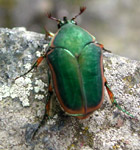

• June Beetle
Look
for these beetles, also known as may or june bugs, during the months of May through
July. Don't forget to pull off the hard shell, legs, and head before eating. The
larva of the june beetle is also edible and is found in the soil year-round.
•
Kabóca
cicada
Japánban
pirítva eszik: semi.
fáraókabóca (Magicicada septendecim), az USA-ban jelenik meg tömegesen 13 vagy 17 évenként:
http://www.origo.hu/tudomany/20130510-kabocak-milliardjai-lepik-el-az-usat.html
http://www.origo.hu/tudomany/20130530-az-idoszaki-kabocak-rejtelyes-elete.htmlOlajban sütve a legfinomabb
Mivel a nagytermetű kabócáknak - eslősorban a nőstényeknek - rendkívül nagy a tápértékük, ezért sok helyen (főleg a távolkeleti országokban) ínyencségként, rendszerint sütve fogyasztják őket. Az amerikai szakemberek is arra bíztatják az embereket, hogy az invázió idején egyenek minél több kabócát. Még a Smithsonian Intézet blogoldalán is recepteket tesznek közzé a kabócák elkészítésére. Legegyszerűbb változat a fritőzben sült kabóca. Úgy kell rájuk gondolni, mint az ínyencfalatnak számító, szintén ízeltlábú rákokra, mondja Gaye L. Williams entomológus, és mindjárt vonzó falatnak fognak tűnni. Akik már megkósolták a sült kabócát, azt állítják, hogy az ízük is igen kellemes, különösen jól fűszerezve.
•
Csótány
Cockroaches
A
csótány rendkívül egészséges eledel, sőt igazi ínyencfalat, mint a garnéla vagy
a homár, az evésre szánt példányokat steril körülmények között tenyésztik. Különösen
igaz ez a féltenyérnyi, reszelős hangot hallató, szárnyatlan madagaszkári csótányra,
amelyre még soha senki nem panaszkodott, aki ízlelte már.
It may be hard to believe but cockroaches are edible but some military manuals indicate nutrition is low. Obviously, they are a prime candidate for gut purging due to their poor food source. To purge, keep them contained in a fisherman's cricket tube or a cricket raising box for several days. Forwater and a good food source to purge their system use wet lettuce or piece of apple. Remembercockroaches are fast and they can fly. When ready to eat, put them in the freezer to kill, then remove heads,legs and wings and cook. You will find some have an odor. Also, this is one insect that must be cooked dueto parasitic worms they carry. For most to stomach the thought of eating a cockroach, the specimens shouldbe baked dry and ground into flour for mixing with a soup.
•
Weevil
gabonazsizsik,
ormányos bogár
zsizsikek
(Bruchidae), a bogarak (Coleoptera) rendjének több mint 900 fajt számláló családja. Ovális alakú testük 1-10 mm hosszú, színük fekete vagy barna. A potrohvég kilóg a rövid szárnyfedők alól. A legismertebb fajok a borsó- (Bruchus pisorum) és a babzsizsik (Acanthoscelides obtectus). Ezek világszerte előfordulnak; lárváik szárított magvakban élnek és azokat fogyasztják.
A borsózsizsik sötétbarna, nagyjából 5 mm hosszúságú, szárnyfedőin fehér minták láthatók. A nőstény fiatal borsóhüvelyekre tojja petéit. A lárvák átfúrják magukat a hüvelyen és a borsószemeken. Azok a borsószemek fertőzöttek, amelyek egy tál vízbe téve a felszínen úsznak.
A babzsizsik - a borsózsizsikkel ellentétben - száraz magvakra helyezi petéit, és sokszor szaporodik. Hasonlít a borsózsizsikre, de a szárnyfedőjén nincsenek fehér minták.
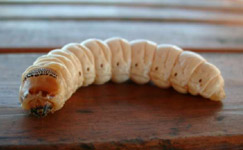
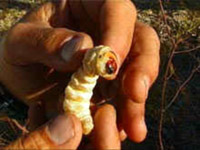
• Witchetty-lárva
witche(t)ty
grub
A húsos lárva gazdag fehérjékben és egyszeresen telítetlen zsírsavakban.
Közép-Ausztráliában, a witchetty-cserje (Acacia kempeana) gyökerén élő, többfajta
éjjeli pillangó, különösen a cossid moth (Endoxyla leucomochla) kb. 7 cm-es lárvája.
Nyersen is fogyasztható, de grillezve sokkal ízletesebb. Lisztes állagú, enyhe
mandulaízű. Az őslakók alaptápláléka volt, az anyatej után a csecsemők első tápja.
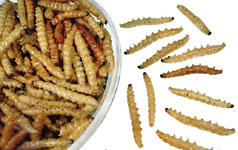
• Bambuszféreg
bamboo
worm
Thai ínyencség: 53% fehérjét tartalmaz (a marhahús csak 20%-ot).
•
Termesz
Termites
are most widely used as food in Africa. The wings are broken off and discarded
and, the rest of the body is fried. The much larger queens are considered a treat
and are often saved for children or grandparents. Termites belong to the order
Isoptera. They are eusocial insects with colonies divided into “castes” that include
workers, soldiers, winged adults and a queen. Colonies of some termite species
build huge earth mounds, called termitaria, which may be up to 20 feet high!
Female
termites with eggs inside, taste like cheese.
termeszek
(Isoptera), cellulózfogyasztó rovarrend; fehér hangyáknak is nevezik őket, bár semmi közük a valódi hangyákhoz (Hymenoptera). Az 1900 termeszfaj nagy része trópusi elterjedésű, de a rendnek sok képviselője van a mérsékelt égövben is. A déli féltekén a termeszek elérik a Dél-afrikai Köztársaság fokföldi részét éppúgy, mint Ausztráliát, Új-Zélandot és Tasmaniát; az északi féltekén olyan messzi északra is találhatók fajok, mint az észak-amerikai Maine és Vancouver, Európában Franciaország atlanti-óceáni partvidéke, Ázsiában pedig Dél-Korea és Japán északi része. Faárukban különféle fajokat behurcoltak természetes elterjedési területükön kívülre.
Valószínűleg csótányszerű ősökből fejlődtek ki, és sok közös jellemvonáson osztoznak a Cryptocercus nembe tartozó legősibb ma élő csótányokkal. Noha legkorábbi ősmaradványaik az alsó kréta időszakból (kb. 130 millió évvel ezelőttről) származnak, feltehetőleg sokkal korábban megjelentek, talán a felső perm időszakban (mintegy 230 millió éve).
A termeszek lágy testű rovarok, kasztrendszerű kolóniákban, bolyokban élnek. Három fő kasztjuk van: a szaporodóképes egyedek, a dolgozók és a katonák. A hártyásszárnyúaktól (hangyáktól) eltérően mindkét nem azonos számban fordul elő, bár csupán a szaporodóképes egyedeknek van teljesen kifejlett ivarszervük. Kolóniánként jellemzően egy szaporodóképes pár - király és királynő - található. Ezek szárnyas, rajzó egyedekből fejlődnek ki, és kemény, pigmentált testük, valamint összetett szemük van; a rajzási repülés után a szárnyakat ledobják. A király 1-2 cm hosszú marad, de a királynő potroha a peterakás megkezdése után megnagyobbodik, és végül akár a 11 cm hosszúságot is eléri. A dolgozók és a katonák nem szaporodóképesek. A dolgozók alkotják a kolónia legnépesebb kasztját. Nem látó, halvány színő rovarok, rágásra módosult szájszervvel. A katonák szintén vakok, és a fészek védelmére - fajtól függően - megnagyobbodott rágóikat használják, vagy kémiai eszközöket vetnek be.
A termeszek vagy fában, vagy föld alatt készített fészkekben élnek; ezeket elzárják a külső levegőtől, hogy fenntartsák a magas páratartalmat, de előfordul, hogy szellőztetőjáratokat építenek, hogy megkönnyítsék a levegő fészken keresztüli diffúzióját. A legszembetűnőbb fészkek a szavannás élőhelyeken világszerte előforduló termeszvárak. Ezek kupola vagy kúp alakúak lehetnek; Afrikában a gombatermesztő Macrotermes-fajok várai elérhetik a 9 m-es magasságot. Ausztráliában az Amitermes meridionalis-faj ék alakú fészkeket épít; ennek hossztengelye mindig észak-déli irányú (ezért is nevezik őket iránytűtermeszeknek). A termeszek nagy várának külső fala rendszerint megkeményedett földből készül; a belső teraszok anyaga fadarabok és ürülékanyag keveréke, amely kartonpapírra hasonlít. A termeszvárban gyakran sok más állat is élősködik: gyíkok, kígyók és madarak. A termeszfészkekben gyakran találhatók termitofilek, azaz olyan rovarok, amelyek képtelenek életben maradni a gazdafaj fészkén kívül. Még olyan termeszek is akadnak - az inquilinus („társbérlő”)-fajok -, amelyek csak másik termeszfaj fészkében képesek életben maradni, és a gazdafaj fészkének anyagával táplálkoznak (fészekparaziták).
Az új kolóniák létesítésének módszere a rajzás. A szárnyas egyedek az év bizonyos időszakában fejlődnek ki, és a dolgozók által készített alagutakon hagyják el a fészket. Akkor rajzanak, amikor kedvező a környezeti tényezők összhangja. A kirajzás egy időben zajlik le egy adott földrajzi szomszédságban lévő fészkekben, s ez lehetővé teszi, hogy a különböző kolóniákból származó egyedek egymás közt szaporodhassanak. A szárnyas alakok gyenge repülők, és - hacsak a szél föl nem kapja őket - nem szóródnak szét néhány száz méternél távolabb. A repülés után hamarosan ledobják szárnyukat, és az ellenkező nemű egyedek párba állnak. A pár kis fészket ás, és befalazzák magukat nászkamrájukba; csupán ezután párzanak. A teljesen kifejlett királynő 50 éven keresztül naponta 36 000 petét rakhat. A termeszek meglehetősen hosszú életűek: a dolgozók és a katonák 2-5 évig élnek, a szaporodó pár pedig sok fejlett fajban 60-70 évig is elél. A termeszek epimorfózissal fejlődő rovarok: nem mutatnak elkülönült lárvális, báb- és kifejlett stádiumot, hanem fokozatosan fejlődnek a vedlések folyamán. A kolónia korai életszakaszában az összes nimfából dolgozó és katona fejlődik. Szárnyas egyedek csak akkor jelennek meg, amikor a telep már jól megalapozott.
A termeszek cellulózzal - a növények egyik fő alkotórészével - táplálkoznak. Ennek megemésztéséhez belükben különféle szimbiontáknak „adnak szállást”. Az ősi termeszek ostoros állati egysejtűekre támaszkodnak a cellulóz lebontásában, a fejlettebbeknek (Termitidae család, amelybe az összes termesz mintegy 75%-a, 1413 faj tartozik) baktériumflóra él a belében. Csak a dolgozók képesek magukat táplálni, és ők táplálják a kolónia többi tagját is. A Macroterminae alcsaládba tartozók a fészekben ürülékanyag-lépeken Termitomyces szimbionta gombát termesztenek. A gombák növekedésük folyamán a termeszek által fölhasználható anyagokká bontják le a lépeket. Ezek a termeszek a gombákat és a lépeket is fogyasztják.
A termeszeket gyakran tartják kártevőknek. Noha az ismert fajoknak csupán 10%-a okoz gazdasági kárt, ezek a fajok nagy pusztítást visznek végbe. A föld alatti termeszek ellen - amelyek a talajon keresztül jutnak be a faszerkezetekbe, mivel állandóan érintkezésben kell lenniük a talaj nedvességével - viszonylag könnyű védekezni: rovarirtó szereket kell helyezni a védeni kívánt szerkezetek körül ásott árkokba. A farágó termeszek (Kalotermitidae) azonban abban a fában fészkelnek, amellyel táplálkoznak, és ellenük sokkal nehezebb a védekezés. Legjobb eljárásnak a kifüstölés bizonyult.
•
Hangyatojás
red ant
A vöröshangya-tojást
(tkp. hangyabábot) konzervnek Thaiföldön úgy teszik el, hogy megmossák, majd 30
mp-ig forralják, utána sós lében tartósítják
http://www.hollowtop.com/finl_html/ants.htm
hangyabáb-gyűjtés
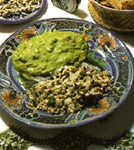
Escamoles (hangyatojás) - Liometopum spp.
hangyabáb, mexikói kaviár
A maguey agávék gyökerei között élő feketehangyák bábja, a mexikói parasztok sosem teszik tönkre a hagyngyabolyt, így évente több kilót is gyűjthetnek egy helyről, sokszor 40 éven át. Hagymával, fokhagymával megpirítják és guacamole-val tálalják.Ants and ant larvae are edible (except fire ant) and tasty. The formic acid mostly disappears when they areboiled. Black ants can be eaten raw whereas fire ants are not considered to be edible. Certain tribes of Native Americans produced what is said to be a flavorful honey-ant wine. Ants generally have a vinegar flavor because they're loaded with formic acid, a chemical similar to the acetic acid invinegar. In other countries such as Thailand, they sometimes substitute ant juice when recipes call forlemon. Larger ants can be squeezed onto your fresh wild salad.
Fire ant pupae taste like watermelon.
Leaf-cutting ants (also known as "big butt ants") have a walnut flavor.
•
Mézhangyák
a
hártyásszárnyúak (Hymenoptera) rendjének hangyafélék (Formicidae) családjába tartozó
több különböző hangyafaj közös neve; jellemzőjük a mézharmat-raktározás különleges
módja. (A mézharmat emésztési melléktermék, amelyet főként levél- és pajzstetvek
váladékaiból gyűjtenek a hangyák.) A mások által etetett dolgozót „mézesbödön”-nek
hívják. A mézharmat a mézesbödön potrohában raktározódik; ez a normális méret
sokszorosára dagadhat. A mézesbödön néha hónapokig lóg egy föld alatti kamra tetejéről
addig, amíg a hangyakolóniának szüksége van a raktározott táplálékra. Ingerlésre
a mézesbödön visszaöklendezi az édes mézharmatot.
A
különféle mézhangyáknál a jelek szerint egymástól függetlenül fejlődött ki ez
a tárolási módszer. Közéjük tartoznak a Melophorus, a Leptomyrmex, a Plagiolepis,
a Camponotus, a Myrmecocystus és a Prenolepis nemek. A mézhangyákat helyenként
különleges ínyencségnek tartják; vagy az egész mézesbödönt, vagy csak annak aranyszínű
potrohát eszik.
•
Óriáshangyák - Atta sexdens v. Atta laevigata
A
janomami indiánok
fogyasztják az óriáshangyákat, akik a Venezuela és Brazília
határán, a Paríma-hegységben és az Orinoco forrásvidékén élnek több ezer éve.
Módfelett harcias nép, s gyakran keverednek összetűzésbe a szomszédaikkal. Ellenségeiket
kitartóan – akár hetekig – követik az erdőségekben. Többnejűségben élnek, s ha
a közösségen kívülről akarnak újabb asszonyt szerezni, akkor nem ritkán hadjáratot
indítanak, majd szétosztják egymás között a legyőzött ellenség asszonyait.
http://www.geographic.hu/index.php?act=napi&id=8967



•
Méhlárva
a
mézelő méh lárvája, más nevén álca, bee larvae
Honey
bees are accepted around the world as a favored food. They are edible at all stages
(larval, pupal and adult) of growth. Boiling tends to break down their poison
which is basically protein and at boiling temperatures, the stinger softens. Also
pounding them before boiling is effective.
http://www.apithera-jp.com/english/hatinoko.htm
http://www.chinabees.com/htm3/cpjs/bee%20larva.htm
http://www.fao.org/docrep/w0076e/w0076e19.htm
http://www.fao.org/docrep/w0076e/w0076e20.htm
•
Darázs
A
darázslárváknak mogyoróízük van.
Japánban a vízben főtt lárvák neve: hachi-no-ko.
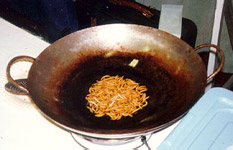
• Lisztbogár
és lárvája
mealworms
A nagy lisztbogár (Tenebrio molitor) lárvája
gyakorlatilag minden kereskedésben megtalálható. Táplálási szempontból nem a legjobb
eleségállat, a lárva kemény kitinváza nehezen emészthető. Ezt a problémát áthidalhatjuk,
ha az átalakulás állapotában lévő imágokat etetjük fel állatainkkal, melyeknek
még nem keményedett meg külső páncélja. A lisztbogár magas zsír és alacsony proteintartalommal
rendelkezik, Ca 0.1 és P 0.2 tartalma messze elmarad a szükséges értéktől, amely
a csontozat normális fejlődéséhez kell, ezért kezeletlenül nem ajánlatos feletetni
őket.
http://www.hollowtop.com/finl_html/mealworms.htm
szöveg: tenyésztés
Mealworms are eaten plain (after being cooked of course!) or in a wide variety of dishes such as Mealworm Fried Rice!
Mealworms as adults are about one inch long, are nocturnal, and black, but the tan larvae are best to eat. An example of one you'd like to eat is pictured at left. Mealworm adults and larvae are usually found in "meal", dry grains, flour, etc.
Mealworm
Fried Rice
Ingredients:
1 egg, beaten, 1 tsp. oil, 3/4 c. water, 1/4 c.
chopped onions, 4 tsp. soy sauce, 1/8 tsp. garlic powder, 1 c. minute rice, 1
c. cooked mealworms
Directions:
Scramble
egg in a saucepan, stirring to break egg into pieces.
Add water, soy sauce,
garlic and onions. Bring to a boil. Stir in rice and (mealworms). Cover; remove
from heat and let stand five minutes.
Lisztkukac (Tenebrio molitor)
Egy kis helyreigazítás. Ugyanis az eleségállat magyar közszájon forgó elnevezése hibás nem kukac hanem bogár.
Az egyik legkönnyebben beszerezhető eleség. Olcsó ám magas zsír és kevés protein tartalma miatt nem a legmegfelelőbb táplálék. Sok terrarista a őszegény ember hüllőjének eledeleő-ként is emlegeti
A lárva kitinváza kemény és nehezen emészthető. Kálcium és foszfor tartalma jóval kevesebb az elfogadhatónál, ezért mindenképpen vitaminporozni kell. Önállóan főeleségként semmiképpen ne alkalmazzuk, csak kiegészítésként, mert ha csak ezzel etetünk, zsíros beteg állatot fogunk eredményül kapni.
A kifejlett bogár 1,5-2 cm-es a hímek első lába hajlott a nőstényeké egyenes. A lárvák bábozódás előtt 2,5-3 cm-esek, de előfordul, hogy elérhetik a 3,5 cm-t is. A kifejlett bogár kb. 3 hónapig él, ami alatt 150 petét rak. 27°C-on a peték 5-7 nap alatt kelnek ki, a lárva állapotuk 42-49 napig tart, és 6-10 napig vannak a bábokban. Ivarérettségüket a bábból való kikelés utáni 10-12. napon érik el és a megtermékenyített nőstény 7 nap múlva rakja le a petéit.
Tenyésztésükhöz használjunk egy minimum 60x50 alapterületű 30 cm magas edényt ami lehet fa, műanyag vagy üveg. A tartóláda tetejét szúnyoghálóból készítsük, a megfelelő szellőzés biztosítása végett. Mindenképpen fedjük az edényt mert a kifejlett bogár képes repülni.
Kb. 350g tápkeveréket helyezzünk be amit lehet tiszta búzakorpa vagy ha azt akarjuk, hogy állataink jól fejlődjenek adjuk nekik az alábbi keveréket.
150g búzaliszt
150g zabpehely
300g korpa
30g sörélesztőt
De kenyérmorzsát is tehetünk a tápkeverékbe. Kezdésnek 800-1000 db hernyót helyezzünk a keverékbe. Hetente adjunk nekik néhány vékony szelet almát répát, krumplit. Az el nem fogyasztott maradékokat két nap múlva vegyük ki.
A lárvák viszonylag ellenállóak a hideggel szemben, ezért tárolhatjuk őket a hűtőszekrényben feletetésig.
•
Indiai
tutajpoloska -
Lethocerus indicus Lep. & Serv. (= Belostoma indica Vitalis)
giant
water beetle, Thai giant waterbug [angol], punaise d'eau géante [francia], ca
cuong [vietnami], maeng-da, maengda-na [thai], kepik air [indonéz]
Ez a legkeresettebb
ínyencfalat az ehető rovarok között!
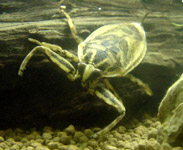
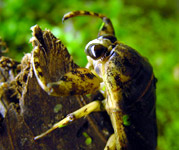
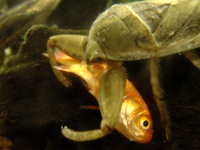
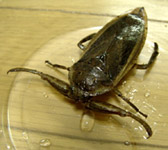
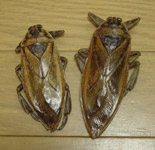
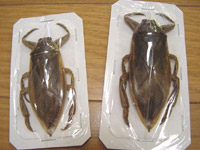
A
tutajpoloska gorgonzola-sajt ízű potroh-nedve fűszerként mártogatós szószokba
használatos. Kevés kell belőle, ritkasága miatt egyre drágább, ezért hamisítják
is. Magát a bogarat is megeszik. 6-8 cm nagy, tavak, folyóvizek elárasztott rizsföldek
ragadozója.
További képek: http://plaza.rakuten.co.jp/lethocerus/diary/őctgy=1
nam prik maengda
szósz összetört tutajpoloskából, só, cukor, fokhagyma, hagyma, halszósz, zöldcitromlé, csilipaprika hozzáadásával
For some time now I have been urging friends to consider an effort to save the ca cuong, whose scientific name is Belostoma Indica Vitalis (Lethocerus Indicus Lep). A marvelous water bug long prized by Vietnamese epicures, it is in danger of becoming extinct. That would be a loss not only for gastronomy but really for anyone who cares about preserving the diversity of life on our planet. A project to study and rescue the ca cuong will surely cull from the woodwork entomologists of a gastronomic bent. I was challenged to explain why we should even bother to take the trouble. Perhaps you will be persuaded by my notes, appended below: Notes on the Ca Cuong Water Bug My earliest memories of the ca cuong can't be separated from the pleasures of eating. My grandmother would prepare bun thang, noodles in a glorious chicken broth topped with thin slivers of omelette, steamed chicken breast, and cha, a smooth textured pate. It would be served with nuoc mam, a fish sauce mixed with lemon juice, minced ginger and garlic, and just one drop of the ca cuong essence. That one drop alone suffused the broth with an indescribable fragrance. Enough for the whole family. Even at the age of five I knew that the ca cuong was a wonderful precious creature. In times of war and social turmoil, vials of ca cuong essence was the preferred liquid (!!) asset. It was considered better than gold because, like rare stamps, much value could be concentrated in a small and portable object. Just grab it and run. My mother told of families she knew who escaped from Laos to Thailand, driven out by the terror of French bombs (this was around 1945 or 1946, during the First Indochina War when the French tried to restore colonial rule). They would flee with barely the clothes on their back and (luckily for them) vials of this sublime essence. It gave them the capital they needed to start a new life. Thirty years of living in the US has not diminished my yearning for the ca cuong; the cherished bun thang is incomplete without a drop of ca cuong juice. The tiny vials brought by visiting relatives during the early 1960s were gratefully received and sparingly used. Two years ago, in the course of chatting with an uncle who travels frequently to Vietnam, I discovered that the beloved ca cuong was hardly seen around anymore. So in June 1990, when I had the opportunity to participate in some seminars in Hanoi and Saigon, I was determined to learn more about its fate. In the course of my investigation, I invited G., a dear friend of mine who lives in Paris, to put himself in a Proustian mood and tell me his memories of the ca cuong. He demurred, claiming to have neither Proust's soul nor his "etoffe" (literally: stuff, fabric, cloth). The word ca cuong releases only "reflexes" of a documentary nature, he avers. Then he offers a smattering of the "disorder" that passes through his head: an earthy proverb, some sociological and economic observations, a sad reflection, etc. (His actual comments, in French, defy translation.) The proverb -- "ca cuong chet den dit con cay" -- also is difficult to translate. It's a variant of the observation that one can't change the basic nature of things. This is the literal version: "the ca cuong, dead, on reaching the anus is still (peppery) hot". The essence of the ca cuong is located in its tail area; savoring its flavors, one runs the risk of feeling its effects in one's own tail area. The ca cuong also is thought to be an aphrodisiac, adding further ambiguity to the proverb. Only the male has a developed bladder. During the mating season, he secretes a special essence from his bladder to attract females of his species. According to Do Tat Loi, an authority on traditional sources of Vietnamese medicine, through experiments scientists have found that small doses of the essence produced by the male ca cuong stimulates the nervous system and the genital areas. In large doses, it has a toxic effect. The ca cuong is a large, greyish brown water bug that is often found in water-logged fields, ponds, and rivers. Under water, these bugs are usually observed -- head pointed down, tail pointed up -- attached to a blade of grass. Lying in this position, the tip of its abdomen held above water level, two skinny breathing tubes extended up to suck in air, the ca cuong waits to trap its prey. On either side of its soft furry stomach are two sharp tubes that it can extend or retract at will. This is the instrument the ca cuong uses to sting its victims, and it can inflict a painful bite. It mainly subsists on a diet of fish eggs and molluscs. At full maturity it is seven to eight centimeters long, three centimeters wide, and weighs about nine and a half grams. Dissecting the ca cuong, one finds that its digestive tract is approximately 45 cm long; this includes a small tube on the top that forms the aesophagus. At the lower end of the tract is a large swelling that discharges a pungent smelling liquid. Adjacent to this are two sharp tubes which the ca cuong can extend or retract. If you pull hard at these tubes you will be able to pull out its entire digestive tract. Underneath this creature's chest, near the back area, you will see two small tubes (the vesica). Each one, white in color, is 2 - 3 cm long, 2 - 3 mm wide; inside the vesica is an aromatic liquid, the ca cuong essence. However only in the male is this organ developed. They breed during the rainy months -- in late spring and early summer. Their eggs are laid in buns that resemble a mulberry fruit and attach to herb or water rice plants. Each bun holds hundreds of eggs. The parents hover about the egg bun. It is hypothesized that they are there to protect the eggs and occasionally to fan them with air. It takes 40 to 50 days from the time the egg hatches for the ca cuong to reach full maturity. The ca cuong are found in both northern and southern regions, but in the past they were most numerous in the north as they preferred both a warm climate and a cold season. Like me, G.'s memories tend toward the epicurean. He recalls that ca cuong season comes in late spring, early summer. The ca cuong is caught, cooked whole, and then mashed in a bowl of nuoc mam. This dish, bap cai luoc ("cabbage cooked in water"), is a cousin of the Italian bagna caoda. The family gathers round, dipping cabbage leaves in the shared nuoc mam bowl. Yet the sensations evoked have less of a physical or olefactive quality. What dominates for him are the feelings of a new season, of changing seasons. There are certain types of ca cuong that can be eaten whole, tossed in a saute or ground up and added to the filling of the traditional banh trung, special moon cakes prepared for the Tet or Vietnamese New Year holiday. The ca cuong is an essential ingredient in another famous dish, the cha ca, a pate of fish cooked at the table with a leafy vegetable from the watercress family, which is then dipped in a mam tom or shrimp paste sauce to which a drop of the ca cuong essence is added. Its fragrance is difficult to describe. Not long ago I went to have my hair washed and cut. Suddenly I smelled something that reminded me of the ca cuong. It turned out to be a hair rinse of apple cider vinegar. Socio-economic aspect: in the north, chemical fertilizers and pesticides have driven away the ca cuong. There are practically none left. In the south, they huddle in the Plain of Canes. But the ca cuong essence can no longer be bought in the open market. (That was my experience: one of my aunts, who lives in the old quarters of Hanoi, scoured the entire city for ca cuong essence in her desire to indulge my obsession. Alas, no luck!) The apparent reason is that the market has been cornered by people who plan to leave the country (either through the Orderly Departure Program or other means). They have systematically bought up this liquid in place of dollars or gold. Abroad, they can practically name their price. According to my friend, the gastronomes of Bolsa Avenue in Orange County (a reference to a well-known hangout of affluent Vietnamese-Americans) dream of true ca cuong, not the synthetic stuff Thailand exports. (The Thai stuff is horrible. I remember it well. My teeth still rattles from the taste.) The few ca cuong left today hover around Ho Tay (West Lake) in Hanoi. During ca cuong season, attracted by the projection lights on the Ba Dinh esplanade, they fly around the mausoleum of Uncle Ho. They in turn draw out the Hanoians, who congregate around the lampadaries of the esplanade. Other friends also have come to the rescue with intriguing stories about the ca cuong in antiquity. David Marr, who is known for his marvelous scholarship on Vietnamese history, sent from Australia an article by Nguyen Cong Tieu on Tonkin's edible insects. It was published in the Bulletin Economique de l'Indochine over 60 years ago (1928 to be precise). I was not surprised to learn from the author that this delightful bug was party to an ancient diplomatic flap, one of many in the long and difficult history of Sino-Vietnamese relations. Apparently the gastronomic qualities of the ca cuong was appreciated as early as the period of Emperor Trieu Da (207-137 BC). Legend has it that Da, a Chinese general who became Emperor of Annam (central Vietnam), sent a certain number of these insects as tribute, along with other precious objects, to the ruler of the Middle Kingdom (China). The Son of Heaven (aka the Emperor of China) inquired as to its name. To inflate its value, Da concocted the name "cinnamon-tree weevil" (charanon du cannelier) in honor of its distinctive fragrance. The disbelieving Son of Heaven sent back a reproachful letter in the form of a play on words. The gist of the message: he knew quite well that no Annamite called it by that name, and Trieu Da ought not assume that his betters would be gulled by such monkey-shine. As a result of this incident the insect came to be called ca cuong, actually a mangling of the word "Da cuong" which literally translates as "Da embarrassed" (or Da caught with his pants down). Conclusion: to allow the gradual extinction of this fabulous creature is unthinkable. From a food lover's point of view, it may be better to give up capers or truffles. Moreover, an effort to save this species may further the science of entomology: studying the life cycle of the ca cuong could offer insights that may advance research in integrated pest management (IPM). A project to study the ca cuong in order to prevent its extinction has many beneficial side effects: 1. It can help promote the environment. A hospitable climate for the ca cuong is one that is free from chemical fertilizers and pesticides. Thus an effort to save the ca cuong from extinction is but one component of a wider effort to promote sustainable agriculture. Vietnam, like other Third World countries, spends far too much of its scarce foreign exchange resources on imports of chemical fertilizers whose long term benefits are questionable at best. This is a pity, because we have the technical and physical resources to produce our own organic fertilizers. Nutrients from organic fertilizers are released in amounts that plants can absorb which eliminates the problem of excess nitrates leaching out during a rain. For a number of reasons that I will not go into here, organic fertilizers also augment plant resistance to disease. [Update: Dr. Phan Van Huu, a Canadian-based specialist in biology, founded the Thien Nong company in 1989 to manufacture a non-chemical fertilizer. He started with a small workshop in Nghia Do (Hanoi) and now has four affiliate plants in Quang Binh, Nam Ha, Ha Tay and Vinh Phu. Five additional provinces have negotiated with the company to set up local factories. A research committee of Vietnam's Union of Sciences and Technology headed by Professor Ha Hoc Trac concluded that Thien Nong fertilizer can increase plant productivity by ten to fifty percent. Recently, Thien Nong exported its first 10,000 tons of biological fertilizer to Thailand.] 2. Cultivating the ca cuong and exporting its essence may generate hard currency revenues (recall the gastronomes of Bolsa Avenue!) of an amount not to be sniffed at. It would constitute an important source of supplemental income to the farmer and provide an incentive to shift away from environmentally hostile methods of agriculture. It is not impossible that non-Vietnamese epicures, upon tasting the ca cuong flavor, may fall under its spell. This would greatly expand the market for ca cuong essence. 3. A project to study the conditions that would allow the ca cuong to flourish would enhance other research in integrated pest management (IPM) techniques that would be appropriate for environmental conditions in Vietnam. Developed in conjunction with a traveling program to stimulate the study of field entomology among rural school children, it would promote greater understanding and acceptance of IPM methods (and also demonstrate that we don't need expensive laboratory equipment to teach good science.) The rural school children are Vietnam's future farmers; a hands-on program that teaches the investigation techniques of the entomologist may be their first introduction to IPM concepts. As the children share what they have learned with their parents, village elders may be more receptive to environmentally sound ways to handle pests. In my opinion, an effort to save the ca cuong is a metaphor for saving what is delightful in our country. Given the conditions the ca cuong requires to thrive, one could say that what is good for the ca cuong is also good for the children of Vietnam (a healthy and chemical free environment!) End of Notes. March 1991 (updated April 1994) He has spent several years studying the life cycle of the ca cuong. He says they are gluttonous carnivores, sucking fluid and blood from molluscs, small frogs and fishes, and even other insects. He has even heard of instances where they have attacked large warm- blooded animals. There are two types that he is studying. One kind has a rather nasty disposition, he observes. Despite their repellent appearance and demeanor, his sentiments towards them are altogether humanitarian: he would like to find a way to extract the essence without causing harm to the ca cuong. He told me he had arrived at the same conclusion as I had -- that peasant households could learn to breed the ca cuong as an additional source of family income; he showed me plans for an experimental project to encourage rural households to raise this water bug in their ponds. He is an acknowledged authority on the ca cuong, and was invited to contribute an article on the ca cuong for the "Red Book" which is a well-known and highly regarded compilation of Vietnam's endangered species.
http://coombs.anu.edu.au/~vern/wild-trade/docs/cacuong.txt
how the liquid-producing sacs are harvested. Belostoma is also eaten although it is not very fleshy. After the wings, legs and caudal appendages are removed, it is grilled over charcoal or steamed in a special pan (double boiler, the upper part of which has a bottom with a hole through which steam can pass). In either case, only the soft parts within the thorax (tor) are eaten. A third procedure involves chopping up the insect and sauteing it in fat, in which case the entire insect is eaten including the chitinous covering. Children collect Belostoma eggs from aquatic plants and eat them raw or grilled. The adult bugs are captured using special "fish baskets" and at lights.
At three and a half inches long, giant water beetles (maing daa) look absolutely monstrous but they're actually rather delicious and the Thais regard them as the nation's number one edible bug.
These days, they've become quite rare in the wild so most are raised on bug farms. A street value of 5 baht per insect makes this a lucrative business.
When you're faced with a giant water beetle for the first time - usually on Soi Cowboy - it's difficult to know which bits to eat and which to throw away. The meat makes good eating but the hard parts should be discarded.
Pull
the legs off and nibble any meat from the wet ends.
Rip the head and wings
off and throw them away.
Detach the long abdomen and suck the paste out of
it. If you're lucky, it will be full of chewy eggs.
Prise open the thorax
and enjoy the tuna-like meat inside.
-----------------------------------------------
Stink bugs taste like mint or cinnamon.
CLEANING AND PREPARING THE INSECTS
Insects, like lobster, are best if cooked while alive or fresh frozen. In contrast to beef, lamb, and poultry, postmortem changes rapidly render insects unpalatable. To facilitate meal planning, many species of insects may be kept alive for several days in the refrigerator. In fact, refrigeration before cooking is advised for the more active forms because it slows down their movements and facilitates handling.
Mealworms and crickets are easy to obtain from bait and tackle shops, or from distributors. If mealworms came packed in newspaper, they need to be changed to bran meal or corn meal or starved for 24 hours, to purge their guts. To separate mealworms from any attached food, waste material, or other debris, place a handful of them in a colander and gently toss. Remove any dead worms, and wash the remaining live insects under cool water. Place the worms on paper towels and pat dry. The mealworms are ready to be cooked or frozen for later use. Crickets should be placed in a refrigerator before attempting to wash them, to slow them down. If, before they are completely washed, they become very active, put them back in the refrigerator. You may want to remove the legs, wings, and ovipositor of crickets after dry roasting them.
PREPARING DRY-ROASTED INSECTS:
Take cleaned insects out of the freezer. Spread them out on a paper-towel covered baking sheet. Bake at 200 degrees Fahrenheit for 1-2 hours, until the insects can be easily crushed with a spoon.
Pesthy
Gábor
Szaftos férgek, ropogós tücskök - ránk is a rovarevés vár
http://www.origo.hu/egeszseg/20151013-rovareves-tucsok-sertes-marha-csirke-tapertek-taplalkozas.html
Európában és Észak-Amerikában az emberek többsége a rovarokat visszataszítónak tartja; csak egészen szélsőséges helyzetekben merülhet föl a gondolat, hogy velük csillapítsuk az éhségünket. Egészen más a helyzet azonban Afrika, Ázsia és Dél-Amerika számos országában, ahol a rovarok - sütve, főzve vagy nyersen - alapvető táplálékforrást jelentenek.
A közép-afrikai gyerekek játék közben hangyákat, lárvákat kapnak be csemegeként. Délkelet-Ázsia városaiban járva lépten-nyomon láthatunk "grillezett" tücsköt áruló utcai árusokat. Sőt még az autóval közlekedő ausztrál bennszülöttek, az aboriginek is képesek órákat vezetni azért, hogy ráakadjanak a mézesbödönhangyák egy-egy rejtekhelyére, ahol azután remek pikniket tarthatnak.
Napjainkra legalább 113 országban maradt fenn a rovarevés, azaz az entomofágia szokása - mutat rá Julieta Ramos-Elorduy, az ehető rovarok egyik legismertebb szakértője, a mexikóvárosi Nemzeti Autonóm Egyetem munkatársa. A témában az ENSZ idén februárban Thaiföldön rendezett konferenciát, az egyre fokozódó élelmiszerválságot látva ugyanis fontos kérdés, miért, illetve miért nem használja ki az emberiség jobban e táplálékforrást. Mint azt Patrick B. Durst holland kutató, az ENSZ Élelmezési és Mezőgazdasági Szervezetének (FAO) munkatársa, a konferencia szervezője elmondta: nem az a cél, hogy tömegesen vegyék rá az európaiakat és az amerikaiakat a rovarevésre, de bíznak abban, hogy a nyugati társadalmak is elfogadóbbak lesznek a rovarfehérjével kapcsolatban, különösen akkor, ha nem kell szembesülniük azzal, hogy valójában rovarokat esznek - írja a ScienceNews.
Ízlés dolga
A nyugati emberek csak végső esetben fanyalodnak entomofágiára, akkor, ha semmilyen más ehető hús vagy növény nem elérhető. A trópusokon és szubtrópusi vidékeken azonban bizonyos rovarokat, például a kifejlett termeszeket vagy bizonyos rovarlárvákat szívesebben fogyasztanak, mint a "megszokott" madár-, hal- vagy emlőshúst. A világon megközelítőleg 1400 rovarfajt esznek meg az emberek, ebből legalább 500 számít rendszeres élelemforrásnak a fekete kontinensen, és mintegy 200 Thaiföldön. Mexikóban - ahol elterjedt az entomofágia - ezernél is több rovarfaj szerepel az étlapon, mégpedig szó szerint, ugyanis éttermekben is rendszeresen felszolgálják őket. Akadnak olyan különlegességek is, mint az agávéhernyó (az óriási Aegiale hesperiaris lepke lárvája), amelynek egy adagjáért 25 amerikai dollárt kérnek.
Afrika nagy részén a mopaneféreg - a Gonimbrasia belina lepke mopanefákon táplálkozó hernyója - számít rendkívül népszerű ínyencfalatnak. A mopaneféregre akkora a kereslet, hogy a biológusok aggódni kezdtek a faj jövője miatt: csupán Dél-Afrikában több mint 1600 tonna szárított mopaneférget adnak el évente. A hernyók fontos fehérjeforrásként szolgálnak a közép-afrikai országokban: egy korábbi FAO-tanulmány szerint a Közép-afrikai Köztársaság lakóinak mintegy 85 százaléka, a Kongói Demokratikus Köztársaság lakóinak 70 százaléka, a botswanaiak 91 százaléka fogyaszt hernyókat.
Miért nem eszünk rovarokat?
1885-ben jelent
meg Vincent M. Holt rövid, 99 oldalas könyve, melynek címe: Miért nem eszünk
rovarokat? Vitairatában - amelyben receptek is szerepelnek - teljesen logikusan
érvel a rovarevés mellett. Többek között fölveti, hogy sokunk undorral fintorogna,
ha főtt vagy sült tücsköt tálalnának föl számunkra, de nagy örömmel vennénk,
ha a rovarok "tengeri rokonai", languszta, homár vagy más rák kerülne
az asztalra. Holott a rákok általában dögevők, a rovarok jelentős része viszont
friss növényekkel táplálkozik.
Fogynak a rovarevők
Számos vidéken azonban eltűnőben van a valaha népszerű rovarevés szokása. Erre a szakemberek Ecuadorban találtak először bizonyítékot, miközben a Platycoelia lutescens nevű ganéjtúró bogarat tanulmányozták. A kutatások folyamán 48 Quito körüli munkás, illetve szellemi foglalkozású lakost kérdeztek arról, milyen szerepet játszik a fehér bogár a helyi étrendben. Mindenki elismerte, hogy a catso blancónak nevezett ízeltlábú kulináris csemegének számít. A munkások mindegyike úgy nyilatkozott, hogy legalább évente egyszer esznek ilyet. Néhányan az egész családot elviszik a közeli mezőkre október végén, november elején, hogy elfogják a talajból az átalakulás után ekkor kibújó kifejlett bogarakat. A megkérdezett 24 módosabb, szellemi foglalkozású ember közül azonban csak egy ismerte el, hogy már kóstolta a catso blancót, a többiek mereven elzárkóztak a bogárevéstől.
Ehhez némileg hasonló jelenséget tapasztalt Kenyában Francis O. Orech, a Princess Anne-i Maryland Eastern Shore Egyetem élelmezéstudományi szakértője. Orech egy dán kutatócsoporttal tanulmányozta az afrikai luo törzs rovarevési szokásait. A törzs tinédzserei és fiatal felnőttei múlt századi csökevénynek tekintik a rovarevést. Egyikük emlékezett, hogy gyerekkorában evett hangyákat és termeszeket, ám a kutatók csak a 45 éven felüliek között találtak olyan egyéneket, akik még tudták, hol lehet biztosan fellelni ehető rovarokat, hogyan kell megfogni és elkészíteni őket.
Kinek a bifsztek, kinek a rovar
A rovarok fogyasztása egészségesebb, mint például a vörös húsoké. A luo törzs által leggyakrabban fogyasztott öt faj között szerepeltek hangyák, termeszek és egy tücsökfaj. A vizsgálatok kiderítették, hogy a luók által fogyasztott fajok mindegyike, kivált a tücsök, jó ásványianyag-forrás. Kutatások kimutatták, hogy a tücskök és a szöcskék azonos mennyisége táplálóbb lehet, mint ugyanannyi marha- vagy sertéshús. Ennek egyik oka, hogy a rovarok húsa általában kisebb arányban tartalmaz vizet, mint a lábasjószágoké. Sok rovar ráadásul gazdagabb ásványi anyagokban, vitaminokban, esszenciális aminosavakban, mint a húsok többsége. A rovarokban a lipidek zöme is hosszú láncú, telítetlen zsírsav, amely egészségesebb, mint a hagyományosan fogyasztott húsokban lévő telített zsírsavak.
33 mód a szöcskék, hangyák, vízipoloskák, pókok, százlábúak és hasonlók elékszítésére
A virginiai Richmondban
idén május 18-án megrendezett Broad Appétit Food Festival legnépszerűbb standját
David George Gordon mondhatta magáénak. Gordon az Eat-a-Bug Cookbook szerzőjeként
a rovarfogyasztás egyik legfőbb népszerűsítője az Egyesült Államokban. Egyszerű
recepteket ajánl - főtt tészta olaszosan, hozzá hatlábú húsgolyók, tücsökből.
Szakácskönyvéből mindent megtudhatunk, amit a rovarhúsról tudni érdemes, az
állatok helyes felszeletelésétől az elkészítés változatos módjaiig.
A rovarburgeré a jövő?
Patrick Durst úgy véli, hogy az európaiak és az amerikaiak jó részét két jelentős aggály tántorítja el a rovarevéstől. Az egyik, hogy nem tartják elég higiénikus ennivalónak a rovarokat, a másik, hogy - akármennyire is egészséges a fogyasztása - a tücsök vagy a sáska mégsem annyira ínycsiklandó küllemű. A hollandiai Wageningen Egyetem szakemberei azt állítják, megtalálták a megoldást mindkét problémára: biotechnológiai eljárással rovarsejteket állítanak elő. Céljuk, magyarázta Marjoleine C. Verkerk kutató, hogy "higiénikus" rovarfehérjéket állítsanak elő, amelyek megszáríthatók, és hozzáadhatók például a pékáruhoz vagy esetleg rovarburgerré formázhatók.
A Fear Factor amerikai élelmiszermárka barbecue, sajtos és mexikói fűszeres ízben kínálja ropogtatni való lárváit
Egy japán konzorcium még távolabbi célokat tűzött ki: űrennivalót készítenének rovarokból. Masamichi Yamashita vegyészmérnök a japán Űrtudományi és Űrhajózási Intézetben segít megtervezni azt a környezetet, amely a jövő űrutazóit veszi majd körül. Erőfeszítéseik fő célja, hogy a rovarokból egyszerre potenciális táplálékforrást és természetes hulladékanyag-újrahasznosítót hozzanak létre az űrhajósok számára. Yamashita és munkatársai olyan ökoszisztéma kialakításán dolgoznak, amelyben selyemlepkék és szenderek bábjai szerepelnek a rákhús ízét idéző tápanyagforrásként.
A cikket az alábbi
címen találja az [origo]-ban, 2008. június 13.:
http://www.origo.hu/tudomany/20080611-szaftos-hernyo-ropogos-tucsok-eltunoben-az-entomofagia-a-rovareves.html
Insect
Snacks from Around the World
Algeria
The
natives of Algeria would collect large numbers of desert locusts to use as food.
They were a valuable resource for the poor population. The locusts were cooked
in salt water and dried in the sun. Not only were they collected for personal
use, but the locusts were traded in the markets as well.
Australia
Australian natives, known as Aborigines, have eaten many different insects
throughout history. Hundreds of Aborigines would come together at the Bogong mountains
to feast on Bogong moths. These moths would gather in large numbers on the cave
floors and in rock crevices. They were harvested, cooked in sand and stirred in
hot ashes. This would burn off the wings and legs. The moths were then sifted
through a net to remove their heads before they were eaten by the Aborigines.
Some of the moths were ground into paste and made into cakes.
Another important insect in the Aboriginal diet was the witchety grub. This was a moth larva that lived in the roots of the acacia bush, also known as the witchety bush. The grubs were eaten raw or cooked in ashes. Cooked grubs supposedly taste like almonds. The grubs were a valued food source in the Australian desert, especially to women and children.
Some of the insects eaten by the Aborigines were very sweet. The natives would dig into the ground looking for the nests of honeypot ants. The workers of these ants collect honeydew from scales and psyllids and feed it to other worker ants, which would become storage containers for the sweet liquid. The "storage" workers could be found in the nests.
The "honeybag" bee, a stingless native bee, also provided sweet treats for the Aborigines. The "honeybag" was actually the bees' hive. In order to find the "honeybag," the Aborigines would catch a bee that was feeding on nectar, use sticky plant juice to stick a leaf or flower petal to it, and set it loose. The bee would fly straight home. The attached leaf or petal would slow down the bee and make it easier to see and follow.
Japan
The Japanese have used insects as human food since ancient times. The practice
probably started in the Japanese Alps, where many aquatic insects are captured
and eaten. Thousands of years ago, this region had a large human population but
a shortage of animal protein. Since the area had an abundance of aquatic insects,
this food source became very important for human survival.
The Japanese still use insects in many recipes. If you were to go to a restaurant in Tokyo, you might have the opportunity to sample some of these insect-based dishes
hachi-no-ko
- boiled wasp larvae
zaza-mushi - aquatic insect larvae
inago - fried
rice-field grasshoppers
semi - fried cicada
sangi - fried silk moth pupae
Most
of these insects are caught wild except for silk moth pupae. They are by-products
of the silk industry. Silk moths are raised in mass for their ability to produce
silk. The larvae, the young silk moths, produce the silk. Once they pupate, they
can no longer produce silk and are then used as food.
Nigeria,
Kwara State, West Africa
People from this area have
been known to feast on termites, crickets, grasshoppers, caterpillars, palm weevil
larvae, and compost beetle larvae. Termites are collected by placing a bowl of
water under a light source. The termites are attracted to the light and will then
fall into the water. If large numbers of termites are gathered, they are sold
at local markets. People of all ages eat the winged reproductive termites, but
the queen termites are considered a delicacy and are only eaten by adults. The
termites are roasted over a fire or hot coals or fried in a pot. After cooking,
the wings are removed and salt is added to taste.
Crickets are collected from soil tunnels which they build. The crickets are roasted over a fire or hot coals. The guts are removed before eating. Several taboos surround eating crickets. Members of the Yoruba tribes do not generally eat crickets. Many worship Ogun, the iron god, and he forbids animals that have no blood. Others believe that eating crickets is childish.
Grasshoppers are prepared and eaten in a manner similar to that for crickets, but there are more grasshoppers than crickets. They are eaten by people of all ages and there are no taboos associated with them. Some farmers will eat uncooked grasshoppers after they remove the grasshoppers' guts.
In some parts of Nigeria, the Cirina forda Westwood larva is reported to be the most important and widely eaten insect. This insect, often called Kanni, is a caterpillar that is collected from the sheabutter tree. It is boiled and dried in the sun before it is eaten. Kanni is widely used as an ingredient in vegetable soup in this region.
A very large edible insect is the palm weevil larva. It can be four inches long and more than two inches wide. The mature larvae are fleshy and grublike with a high fat content. These insects are collected from the trunks of palm trees. They are fried in a pot or frying pan. They are reported to be very delicious.
The compost beetle larvae are even larger than the palm weevil larvae. They live in garbage or manure piles or swampy areas. The end of the abdomen, which contains the guts, is removed before the larvae are washed and fried. Some people refuse to eat this insect because it is found in such "dirty" places.
Bali
Dragonfly and damselfly adults are hunted in Bali. Dragonflies are extremely
difficult to catch but several interesting techniques have been used successfully.
Latex, sticky plant juice, from the jackfruit tree is applied to the end of a
slender stick. This stick is tied to a longer, sturdier stick. The stick is lower
to a resting dragonfly and with a quick tap, the dragonfly is stuck to the plant
juice. Dragonflies are also captured by hand, but one must be very quiet and quick.
If latex is used to catch the insects, it is removed with cooking oil before the
dragonflies are cooked. Sometimes the dragonflies are placed directly on the grate
of a charcoal grilled for cooking. Another method involves boiling them with ginger,
garlic, shallots, chili pepper and coconut milk. The wings are removed before
cooking unless they are charcoal roasted.
According to the book Insect Fact and Folklore, people in Bali often eat dragonflies. They catch them by placing a sticky saplike goo on the tips of sticks and then walking through rice fields. They then break off the wings and fry the bodies in coconut oil with various vegetables and spices. Dragonflies and damselflies make up the order Odonata. Dragonflies are very useful insects. They are predators of the lowly blood sucking mosquitoes we all hate. They are extremely nimble flyers with big teeth (odo=big teeth) for eating small insects.
Thaiföld
https://www.thailandunique.com/
Thaiföldön
közkedvelt a szöcske, sáska, tücsök, lótetű, óriás csíbor, vöröshangya-tojás és
a selyemhernyó is.
A rovarevés valaha az éhség legyőzésére szolgált. Manapság
azonban a thai konyha tradíciójává vált, a rovarok ugyanis kitűnő fehérjeforrást
jelentenek. A piacokon sütve-főzve úgy árulják, mint nálunk a csirkecombot.
De
hogyan is készül az ínyenc eledel? A szöcskét kiöntik a csapdából, megmossák őket,
aztán harminc percig serpenyőben sütik, miközben jól befűszerezik. A fűszerezés
azért fontos, mert elveszi a rovar bűzét. A hangyatojásokat ellenben csak leforrázzák,
és jól megsózzák.
maengda-na, maeng-da (indiai tutajpoloska) - Lethocerus indicus Lep. & Serv. (= Belostoma indica Vitalis)
A tutajpoloska gorgonzola-sajt ízű potroh-nedve fűszerként mártogatós szószokba használatos. Kevés kell belőle, ritkasága miatt egyre drágább, ezért hamisítják is. Magát a bogarat is megeszik. 6-8 cm nagy, tavak, folyóvizek elárasztott rizsföldek ragadozója.nam prik maengda
szósz összetört tutajpoloskából, só, cukor, fokhagyma, hagyma, halszósz, zöldcitromlé, csilipaprika hozzáadásával
My
favourite is malaeng grachon [mole crickets]. They're crispy and have a nice earthy
taste. They live in damp soil so to catch them you have to make a hole in the
ground and pour water down it. The crickets come to the surface to avoid being
drowned. Then you've got to move very fast because they're pretty quick on their
feet!
Forty-four kinds of insects are considered edible by the National Institute of Thai Traditional Medicine. To be absolutely sure that they're safe to eat, Sanga advises that you cook them first. Grilling over an open fire is the method favoured in the countryside but you can also stir- or deep-fry them or add some to a gaeng (curry) or other hot dish. Country people usually remove the wings, hard exoskeletons and (sometimes) the intestines before cooking. When tender some species are devoured with a chilli dip or added to a yam (spicy salad).
''When I was growing up they were easy to find around the farm. Termites were my favourite. They'd fly around the open fire and their wings would shrivel up in the heat and then they'd fall to the ground. We boys would gather up the little bodies and sprinkle them with salt to make a very tasty, crispy snack."
Tarantula spiders are a delicacy among locals and apparently taste like prawns! The Thailand Zebra or Edible Tarantula is roasted over a fire to singe off its hairs. Tarantulas are also eaten by South American rain forest natives, especially females bearing eggs. The Piaroa tribe on the Amazon River hunts the Giant Tarantula. Tarantula spiders or mygalomorphs are generally larger and hairier than other spiders. Their bites are not usually fatal to humans unless the person has an allergic reaction.
Kína
Nymphs
of cicadas, larvae/pupae of wasps and ants were used as delicacies for emperors
and nobles. Locusts (Acrididae, Oxya) are also used as food, not only in China,
but also in Japan and Korea (Pemberton, 1994). Pupae of silkworms which just finished
producing silk was also good food. Predacious diving beetle and giant water-bug
are popular in south China (mostly in Guandong Province). The Thai giant waterbug
(Lethocerus indicus) also appeared in Thai food shops in California (Pemberton,
1988). Dragon flies are caught and grilled, in China, Japan, Laos and Thailand
(Pemberton, 1995). I also heard some people in North China eat fried scorpions.
While visiting my in-laws in Northern China, I was treated with giant silkworm
pupae. They were fried for about 20 minutes with no spice. The mid-gut, which
is the only recognizable tissue in the whole pupa, was taken out and discarded.
I suspect the pupae were in winter diapause because the rest of the pupae was
sponge-like.
Insects
in Chinese Culture
-Zachary
Huang
1.
Sericulture (Lepidoptera: Bombycidae: Bombyx mori)
Sericulture is an invention
by ancient Chinese people. It started about 5,200 years ago according to archaeological
findings. The most commonly used silkworm is Bombyx mori, which is presumably
derived through long-term artificial selection from Bombyx mandarina. Silkworms
were reared indoors at least during the Zhou Dynasty (about 700 B.C.). This can
be inferred from ancient poems written during that period.
Ancient Chinese also had much knowledge about silkworm biology. In the county records of Yong-jia in southern Zhejiang Province in 4th century AD, a method was described to rear silkworm for 8 generations a year by keeping the eggs and in low temperature to avoid diapause in the next generation.
Sericulture in China had great influence on international trade and cultural communication. Silkworm strain and rearing technique were transmitted to the Korean peninsular at the 11th century BC, and to Japan during 5-3rd century BC. Silk Road refers to the route from China to middle East via which silk was transported commercially and the technique of sericulture was also transmitted between 138 to 126 B.C. The ancient Chinese capital Chang-an (now Xi'an) was known as the silk city to the Westerners at the time. Silk routes also existed in south from Sichuan to Burma and India. Silk worm rearing was introduced to Europe in the 6th century A.D.
Silk is still a high class material for ties, clothing, etc. Usually the beddings has to be all silk when a couple gets married. Silk embroidery is also an important skill traditionally.
Other
silkworms:
Tussah silkworm: Antherea pernyi. Used as tribute to emperor 2700
years ago. Food: toothed oak (Quercus acutissima).
Cynthia silkworm: Samia
cynthia pryeri.
Giant silkworm: Eriogyna pyretorum.
There are also seven
other less important insects used for their silk.
2.
Bees
Beekeeping in China has a history of more than three thousand years.
Oracle inscription of bee swarming was found in Shang Dynasty (11 century BC).
King of Zhouwu had a Ňbee flagÓ when leading forces to publish King of Zhou of
Yin Dynasty. The earliest account of beekeeping (Apis cerana) was published in
the 3rd century.
Beeswax was used in traditional medicine as early as the
Han Dynasty (200 BC), and used for candles, wax pills and sculptures in the Tang
Dynasty (1200 years ago). Beeswax was and is still used in the traditional dying
of cloth -- batik. A pattern is first drawn and covered with wax, then dyed, and
when wax is removed by boiling in hot water, the wax-covered area will appear
to be the original color (usually white), and the dyed area usually blue to green.
Beeswax is also used to make a sculpture, covered with clay, the wax is then melted
away and replaced with melted metal. This process is called the lost wax process.
3.
Wax insects
The earliest record of rearing insect for wax (Coccos pella,
named by Frenchman Chavannes as a new species in 1848) was found in the Song Dynasty
(11th century). The species name pella is the transliteration of Chinese beila,
meaning white wax. N. Trigault, a Christian missionary was the first European
to know about wax insect in China (1651). In 1853, W. Lockhat brought wax and
insects from Shanghai to England for study.
Shellac is the secretion of the lac insect (Tachardia lacca). The earliest record of lac is found in Wu Lu (268-289 AD). Shellac is used as medicine for curing various blood diseases. It is also used for dying silk objects, leather or ornaments and used rouge, lipstick, lacquer and glue.
4.
Insect as medicine
There were 21 insects described as medicine in Shennong
Pharmacopoeia (100-200AD). This was expanded to 73 insects in Compendium Materia
Media published in 1578. I will only introduce some very common ones and ones
that I had experience with.
Chinese galls (Wubeizi) are perhaps the most common
insect-related medicine, used for many sores (Tinea, etc). They are produced by
gall- making aphid (Pemphigidae) on Chinese sumac (Anacradiaceae: Rhus). Although
some people nowadays do not realize the insect component because it has a name
emphasizing the plant part, people long time ago knew the insect-plant connection.
In Tai Ping Guang Ji (Copious Record in Taiping Region Period, 980 AD), Li Fang
observed that "in the Xia Mountains and the region of Sichuan there is a
species of insects... they dwell upon the leaves of Chinese sumac, in spring they
oviposit and roll the leaves around to form their nests which are as big as peaches
or plums. The nests are called Chinese gallnuts and can be used as a good cure
for all serious sores. Collectors usually dry and kill them to keep within the
leaves, otherwise, they will slip away through the chinks". (Chou Io, 1990).
The most expensive one is probably Dong Chong Tsia Tsiao (winter caterpillar summer grass). The caterpillar fungus consists of larvae of Hepialus armoricanus (Lepidoptera: Hepialidae) infected with an obligate entomopathogenic fungus Cordyceps sinensis (Clavicipitales, Ascomycotina). The wholesale price is about $700/kilo in China (Steinkraus and Whitefield, 1994). I believe that there are now artificially cultured caterpillar fungus whereby caterpillars are reared and then inoculated with the fungus spores. The pharmacological properties of the caterpillar fungus are similar to these of gingseng. A Chinese medicine book says they are mainly used for weak lungs, coughing and shortness of breath, weak kidney, back pain, impotence etc.
Other common insect-related medicines are egg cases of praying mantis and blister beetles. When I was young, I used to collect cicada exuvia from trees, and sell them for about 2 cents (Chinese, exchange ratio unknown at that time, but probably like 3:1 to US currency) to the local pharmacy (where one could both buy Chinese herbs and also sell them). The cicada molts are supposedly good for scrofula and ulcer. Silkworm frass is also used as a medicine for diarrhea, when I was rearing silkworm as a hobby (when I was about 5-6), I used to collect the frass and trade for a few cents at the local pharmacy. Another time I took in a centipede, which was alive for quite a few days while being dried on the wall with a bamboo stick forming a bow like structure (one side inserted into the head, the other side into the last segment, therefore the centipede was stretched due to the tension and cannot escape). I remember it was worth 10 cents, but I got quite a few sleepless nights when another boy kept reminding me that the centipede was capable of revenge when the time became right (after reincarnation into another life ?I did not know). This last time I was in China (September 1993), I got a kidney stone and had great pain. The doctor told me I had a weak kidney and prescribed 10 (!) centipedes ground with some other herbs. Perhaps due to my childhood experience I still viewed them with awe and did not take that particular prescription.
A cockroach (Eupolyphaga sinesis) is also used as a medicine. It is supposed to help stop bleeding and heal bone fractures, swelling etc. I remember one time my maternal uncle came to our house looking for a roach (must be an emergency: otherwise he could have got one from the local pharmacy -- or he believed a fresh one was better than a cured one -- I could no longer remember). He tore the whole mud-made stove down, making the kitchen a huge mess. The roaches apparently liked to dwell in cracks in the stove.
Apitherapy is now very popular in China, there are now at least three institutes or hospitals famous for apitherapies (Xi'an of Shanxi, Lianyungang of Zhenjiang and Nanjing of Jiangsu). Arthritis is the most popular disease to be treated by bee stings. Recently, apitherapy is also used for both arthritis and for muscular dystrophy in US. Other bee products used for medicine include honey, propolis (used in an alcoholic tonic). Royal jelly is very popular as a health-strengthening food, especially among the "intellectualls" (professors, researchers, etc). Use of pollen as health food is rather recent, perhaps after the Europeans. Queen larvae, mostly by-products of royal jelly production, are also used for making alcoholic tonic.
Ants are used as health food and a medicine, though as usual it is not known what are the active ingredients. There had been an anecdotal report that a village of long-living people (average ~90) attributed their longevity to the habit of frying up ants and eating them. Ant is a major component of a herbal medicine for hepatitis B (Mayi Yigan Ning). This medicine is reported to give a 60% efficiency to convert hepatitis B surface antigen (HBsAg) to serum negative. This compares favorably with the ~30% conversion efficiency using interferon, as reported by medical journals in US. There are also wines and tonic made with ants.
5.
Insects as pets
Insects are often subjects of art in ancient China. Sculptures
(jade crickets), paintings, poems, often feature insects. Insects are also used
for amusement, for example, releasing of large quantities of fireflies was used
for imperial entertainment. Guoguo (Orthoptera: Tettigoniidae, Gampsocleis gratiosa)
is a long-horn grasshopper used as a pet, mostly for people in Northern China.
Dr. Robert W. Pemberton, a cultural entomologist, witnessed the selling of the
singing crickets in Beijing in 1987 (Pemberton, 1989). Insects are housed individually
in nicely woven bamboo ages, each selling for 30 cents (10 cents US) in August.
Earlier in the season, they can sell for about 3 yuan ($1). Most were caught by
farmers, but some are reared. In winter 1988, a male cricket was sold for 50 Yuan
(=$16.70), which was more than one- third of an average worker's monthly salary.
When I was young, I used to rear silkworm sort of as pets. It is also common
to see scarab beetles or dragon flies tied to a string, and used as toys for kids
4-5 years old.
Cricket fighting, which was very popular in ancient China, is slowly being revived. The earliest publication for how to use cricket for fighting is in Song Dynasty (1213-1275). The practice became rare after revolution in 1949, and was banned during the cultural revolution, due to its "bourgeois nature". Now it is making a coming back. There are even Association for Cricket Fighting in Beijing. The association sponsors national tournaments whereby modern equipment such as video cameras are used to zoom in and project the fighting onto many television sets, which enable many viewers to see the fighting simultaneously.
According to Dr. Robert Pemberton, Asians seem to have less phobia for insects compared to North Americans, and enjoy insects more.
6.
Insects as food
Nymphs of cicadas, larvae/pupae of wasps and ants were
used as delicacies for emperors and nobles. Locusts (Acrididae, Oxya) are also
used as food, not only in China, but also in Japan and Korea (Pemberton, 1994).
Pupae of silkworms which just finished producing silk was also good food. Predacious
diving beetle and giant water-bug are popular in south China (mostly in Guandong
Province). The Thai giant waterbug (Lethocerus indicus) also appeared in Thai
food shops in California (Pemberton, 1988). Dragon flies are caught and grilled,
in China, Japan, Laos and Thailand (Pemberton, 1995). I also heard some people
in North China eat fried scorpions. While visiting my in-laws in Northern China,
I was treated with giant silkworm pupae. They were fried for about 20 minutes
with no spice. The mid-gut, which is the only recognizable tissue in the whole
pupa, was taken out and discarded. I suspect the pupae were in winter diapause
because the rest of the pupae was sponge-like.
----------------------